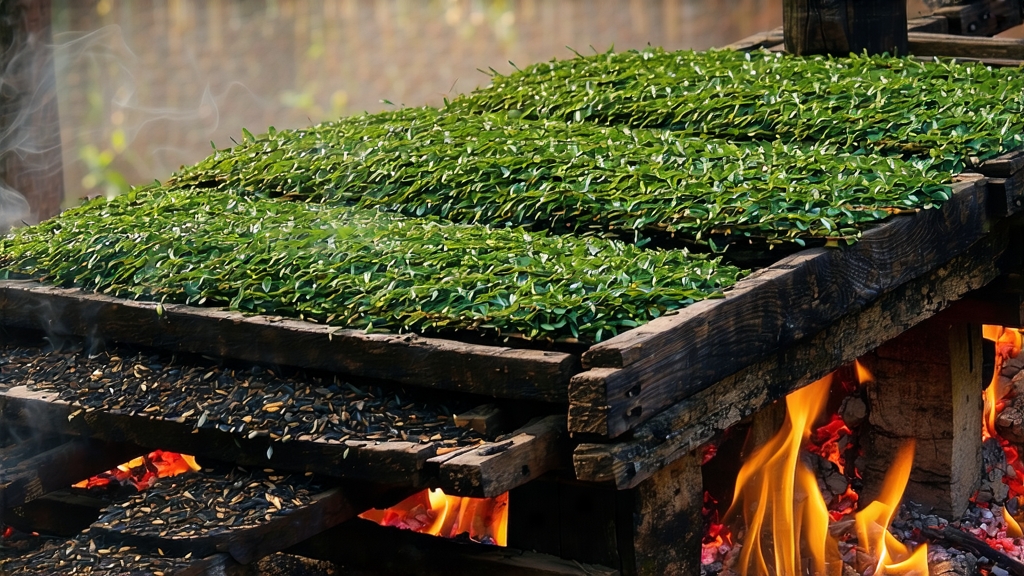
If every tea tells a story, Lapsang Souchong whispers the first chapter of black tea itself. Nestled in the granite gorges of the Wuyi Mountains in northern Fujian, this small-leaf cultivar—known locally as Xiao Zhong—was the accidental protagonist of a global revolution. In the late Ming dynasty, legend says, a passing army commandeered a village tea workshop. To save the harvest from spoilage, farmers rushed the withering leaves over fresh pine fires. The resulting liquor, dark as oxblood and scented with campfire, travelled on Dutch sloops to Europe, where it was christened “Bohea” and became the prototype for every black tea that followed. Thus, Lapsang Souchong is not merely a style; it is the primordial echo of oxidation itself.
Today the name covers two distinct families. The traditional “smoked” variety, Zheng Shan Xiao Zhong, is still produced inside the 60 km² core of the Wuyi National Nature Reserve, at altitudes between 600 and 1 200 m. Here, the Min River funnels humid subtropical air through stands of Masson pine and cedar; the resin perfumes the soil and, later, the tea. Leaves are plucked in late April, when the first two leaves and a bud still hold spring’s cool silkiness. A second, “unsmoked” or “modern” style has emerged since the 1980s for markets that prefer the cultivar’s natural cocoa-and-longan sweetness without the campfire note. Both styles share cultivar, terroir and most processing steps; divergence occurs only in the final act of firing.
Craft begins the moment pickers lay the baskets in cool shade. A gentle 4–6 hour withering reduces moisture to 65 %, softening cells for the rolling that follows. Orthodox rollers twist leaves just enough to rupture 30 % of cell walls, releasing catechins and polyphenol oxidase. Oxidation proceeds on large bamboo trays stacked like drawers in a humid 24 °C room. Craftsmen watch the leaf turn from jade to copper, sniffing every ten minutes for the shift from grassy to apple-sweet. When the edge of the leaf browns uniformly, they slam the brakes with a 220 °C, two-minute “sha qing” bake in iron woks—an arrest so abrupt it hisses like summer rain on slate.
Now the road forks. For smoked Lapsang, the still-warm leaves are transferred to a lower-level chamber of the three-story Qing Lou (pine tower). Fresh pinewood is lit on the ground floor; heat and smoke rise through mesh trays, drying the tea over six to eight hours while impregnating it with guaiacol and syringol, the same aroma molecules that perfume Islay whiskies. Temperature is kept below 80 °c to prevent bitterness; the master controls draft by feel, using a wooden plank to throttle the brick flue. In contrast, unsmoked lots are baked in electric ovens at 70 °c for three cycles, coaxing honey, lychee and dark-chocolate notes that purists say speak the dialect of Wuyi rock-terroir more fluently.
Grading follows leaf size and aroma intensity. Highest grade, simply called “Special,” comprises only the small, intact leaves plucked from the Wuyi qizhong clonal group; it steeps a brilliant claret with a lingering juniper-laced finish. “Pine Tips” denotes broken-leaf lots with stronger smoke, popular in Russia for samovar brewing. “Gift” grade blends Wuyi leaf with lower-elevation Fujian material, balancing cost while retaining the trademark sweet ember nose. Regardless of grade, true Zheng Shan must pass customs under a geographical indication seal; teas produced outside the reserve, even if pine-smoked, are labeled “Waishan” and sell for a third of the price.
Water is the silent ingredient. In Wuyi, spring water percolates through volcanic tuff, emerging soft at 30 ppm TDS—ideal for highlighting the tea’s natural malt. Internationally, use filtered water below 50 ppm; hard water dulls smoke into creosote. For gongfu service, pre-warm a 120 ml porcelain gaiwan or Yixing zi-sha teapot seasoned